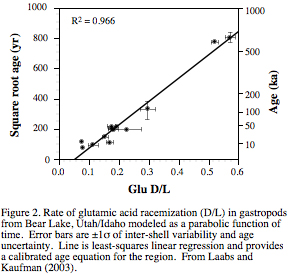
Although the history of the last (late Wisconsin) lake cycle is relatively well understood for the primary lake basins in the Western U.S., little is known about the timing of, or the paleoclimatic conditions associated with, lake-level changes older than the range of 14C dating (~30,000 yr). An accurate chronology is essential if lake-level fluctuations are to be correlated between basins, with the history of Laurentide Ice Sheet, or with other proxy climate data sets. My students and I applied amino acid geochronology to resolve the ages of highstands in three major lake basins in western U.S.: Bonneville, Lahontan, and Bear Lakebasins. In the Bear Lake valley, we calibrated the rate of racemization in gastropods using 14C and tephrochronology (Fig. 2) and applied this to undated highstand deposits in the valley. Additional analyses were completed on samples from Lake Chewaucan, Oregon. Dozens of outcrops were described and sampled for ostracodes and molluscs for amino acid analyses. These studies have led to an improved understanding of the lake-level fluctuations in these basins, particularly those that are older than the range of 14C dating.
Reference
Laabs, B.J.C., and Kaufman, D.S., 2003, Quaternary Highstands in Bear Lake Valley, Utah and Idaho: Geological Society of America Bulletin 115, 463-478.
 Although the history of the last (late Wisconsin) lake cycle is relatively well understood for the primary lake basins in the Western U.S., little is known about the timing of, or the paleoclimatic conditions associated with, lake-level changes older than the range of 14C dating (~30,000 yr). An accurate chronology is essential if lake-level fluctuations are to be correlated between basins, with the history of Laurentide Ice Sheet, or with other proxy climate data sets. My students and I applied amino acid geochronology to resolve the ages of highstands in three major lake basins in western U.S.: Bonneville, Lahontan, and Bear Lakebasins. In the Bear Lake valley, we calibrated the rate of racemization in gastropods using 14C and tephrochronology (Fig. 2) and applied this to undated highstand deposits in the valley. Additional analyses were completed on samples from Lake Chewaucan, Oregon. Dozens of outcrops were described and sampled for ostracodes and molluscs for amino acid analyses. These studies have led to an improved understanding of the lake-level fluctuations in these basins, particularly those that are older than the range of 14C dating.
Although the history of the last (late Wisconsin) lake cycle is relatively well understood for the primary lake basins in the Western U.S., little is known about the timing of, or the paleoclimatic conditions associated with, lake-level changes older than the range of 14C dating (~30,000 yr). An accurate chronology is essential if lake-level fluctuations are to be correlated between basins, with the history of Laurentide Ice Sheet, or with other proxy climate data sets. My students and I applied amino acid geochronology to resolve the ages of highstands in three major lake basins in western U.S.: Bonneville, Lahontan, and Bear Lakebasins. In the Bear Lake valley, we calibrated the rate of racemization in gastropods using 14C and tephrochronology (Fig. 2) and applied this to undated highstand deposits in the valley. Additional analyses were completed on samples from Lake Chewaucan, Oregon. Dozens of outcrops were described and sampled for ostracodes and molluscs for amino acid analyses. These studies have led to an improved understanding of the lake-level fluctuations in these basins, particularly those that are older than the range of 14C dating.
 Although the history of the last (late Wisconsin) lake cycle is relatively well understood for the primary lake basins in the Western U.S., little is known about the timing of, or the paleoclimatic conditions associated with, lake-level changes older than the range of 14C dating (~30,000 yr). An accurate chronology is essential if lake-level fluctuations are to be correlated between basins, with the history of Laurentide Ice Sheet, or with other proxy climate data sets. My students and I applied amino acid geochronology to resolve the ages of highstands in three major lake basins in western U.S.: Bonneville, Lahontan, and Bear Lakebasins. In the Bear Lake valley, we calibrated the rate of racemization in gastropods using 14C and tephrochronology (Fig. 2) and applied this to undated highstand deposits in the valley. Additional analyses were completed on samples from Lake Chewaucan, Oregon. Dozens of outcrops were described and sampled for ostracodes and molluscs for amino acid analyses. These studies have led to an improved understanding of the lake-level fluctuations in these basins, particularly those that are older than the range of 14C dating.
Although the history of the last (late Wisconsin) lake cycle is relatively well understood for the primary lake basins in the Western U.S., little is known about the timing of, or the paleoclimatic conditions associated with, lake-level changes older than the range of 14C dating (~30,000 yr). An accurate chronology is essential if lake-level fluctuations are to be correlated between basins, with the history of Laurentide Ice Sheet, or with other proxy climate data sets. My students and I applied amino acid geochronology to resolve the ages of highstands in three major lake basins in western U.S.: Bonneville, Lahontan, and Bear Lakebasins. In the Bear Lake valley, we calibrated the rate of racemization in gastropods using 14C and tephrochronology (Fig. 2) and applied this to undated highstand deposits in the valley. Additional analyses were completed on samples from Lake Chewaucan, Oregon. Dozens of outcrops were described and sampled for ostracodes and molluscs for amino acid analyses. These studies have led to an improved understanding of the lake-level fluctuations in these basins, particularly those that are older than the range of 14C dating.